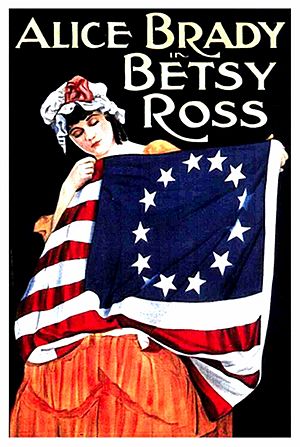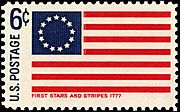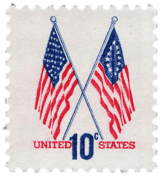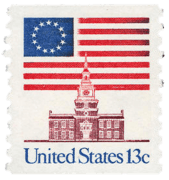Betsy Ross flag facts for kids
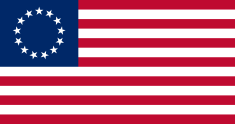 |
|
| Use | |
|---|---|
| Proportion | 10:19 |
| Design | Thirteen alternating red and white stripes, a blue canton with thirteen 5-pointed stars arranged in a circle |
| Designed by | Various |
The Betsy Ross flag is an early design of the flag of the United States. It has 13 red and white stripes and 13 stars in a circle on a blue background. This design matches the Flag Act of 1777. This law was passed during the American Revolutionary War. It said the flag should have 13 red and white stripes. It also said it should have 13 white stars in a blue corner, called a canton. Many people once believed that Betsy Ross, a flag maker, created this flag design soon after the 1777 law.
Contents
The Story of Betsy Ross and the Flag
Betsy Ross (1752–1836) was a skilled upholsterer in Philadelphia. She made uniforms, tents, and flags for the American forces during the revolution. We know she made many things for the war. However, a popular story grew that she was hired by important leaders, like George Washington, to make the first U.S. flag.
According to this legend, the leaders wanted six-pointed stars. But Betsy Ross suggested using five-pointed stars instead. She then made a flag with these five-pointed stars. Today, many experts who study flags do not believe that Betsy Ross designed the flag. But she is still seen as an important symbol. She represents the contributions of women during the American Revolution.
The story of the Betsy Ross flag became well-known around 1876. This was during the Centennial Exposition celebrations. This event marked 100 years since America's independence.
William Canby's Account
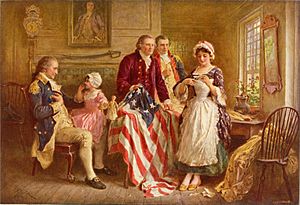
In 1870, Betsy Ross's grandson, William J. Canby, shared her story. He told the Historical Society of Pennsylvania that his grandmother made the "first flag" of the United States. Canby said he heard this from his aunt in 1857. This was 20 years after Betsy Ross had passed away.
Canby's story says that in June 1776, a small group visited Betsy. This group included George Washington, Robert Morris, and George Ross. They talked about needing a new U.S. flag. Betsy agreed to make the flag. She changed their design by using five-pointed stars instead of six-pointed ones.
Even if Canby's story is true, Betsy Ross was just one of many flag makers in Philadelphia. Her only suggested change was the shape of the stars.
Other Stories and Paintings
In 1878, another story about Betsy Ross appeared in a book. This version said that Dr. Benjamin Franklin was involved instead of George Washington. It also described a flag with an eagle and 13 stars around its head.
The first time the Betsy Ross flag design, with 13 stars in a circle, was clearly linked to her was in a painting. This was Charles Weisgerber's 1893 painting, "Birth of Our Nation's Flag." The painting showed Betsy Ross with the flag on her lap. Weisgerber talked to Betsy Ross's family when he created his painting.
The design for the flag in his painting likely came from a book. This book was History of the Flag of the United States of America by George Henry Preble. Preble was a flag expert in the late 1800s. The pictures in Preble's book showed the 1777 flag with 13 stars in a circle. This design might have come from Emanuel Leutze's 1851 painting Washington Crossing the Delaware.
Weisgerber later helped start a group that saved the Betsy Ross House in Philadelphia. He promoted the Betsy Ross story by sending copies of his painting to people who donated money.
Arguments For and Against the Canby Story
William Canby's story about Betsy Ross is still popular. However, many historians question it. There is not much historical proof to support his account.
Arguments against Canby's story include:
- No records show that the Continental Congress had a committee to design the flag in 1776.
- George Washington was leading the army in 1776. So, he could not have led a committee in Congress.
- No letters or diaries from George Washington or other leaders mention a national flag in 1776.
- The Flag Resolution of June 1777 was the first official discussion about a national flag.
- In May 1777, Betsy Ross was paid for making Pennsylvania naval flags, not the U.S. flag.
Arguments that support Canby's story include:
- Robert Morris, a leader mentioned in the story, was a business partner of Betsy's cousin-in-law.
- George Washington bought bed hangings from Betsy Ross and her husband in 1774.
- George Washington was in Philadelphia in May and June 1776. A committee was formed to meet with him. A member of this committee was related to Betsy Ross's late husband.
- Rachel Fletcher, Betsy Ross's daughter, signed a sworn statement supporting the story.
- A painting from 1851 by Ellie Wheeler shows Betsy Ross sewing the flag. If this painting is real, the story was known before Canby shared it.
"First Flag" Debate

Canby's story often calls the Betsy Ross design the "first U.S. flag." But historians do not agree on what the first U.S. flag looked like. They also do not know who made it. Many flag makers worked in Philadelphia at that time. Any of them could have sewn the first American flag.
The Second Continental Congress passed the Flag Resolution on June 14, 1777. This law officially described the U.S. flag. It said:
Resolved, That the flag of the thirteen United States be thirteen stripes, alternate red and white; that the union be thirteen stars, white in a blue field, representing a new constellation.
This law did not say how the stars should be arranged. So, there were many different flag designs. But this law made the Ross flag design, and others like it, official.
Some people give credit to Francis Hopkinson for designing many 13-star flags. He even mentioned designing "the Flag of the United States of America" in a letter in 1780. He asked for payment for his designs. However, his request was not fully accepted.
Historians agree that the United States flag changed over time. It did not have just one design from the start. The flag, like the American Revolution, was created by many people.
What the Flag's Design Means
The meaning of the flag's design is not fully clear. This is because it developed during the American Revolutionary War. A common idea is that the stripes and stars came from George Washington's family coat of arms. But there is no proof of this link. Washington's family coat of arms did have stars and stripes. This is why the flag of Washington, D.C. looks similar.
The Stripes
During the Revolutionary War, the "Rebellious Stripes" were very important. They were often mentioned first when describing the flag. The use of stripes might come from two older flags. One was a 1765 Sons of Liberty flag in Boston. It had nine red and white stripes. Another flag, used in 1775, had 13 blue and silver stripes. These flags likely influenced the design of the American flag.
The Stars
The blue corner with stars, called the canton, might have replaced an older flag design. This happened as people lost hope for peace with Britain. Stars were important symbols in Europe. Their meaning changed based on their shape and number of points. Stars appeared on colonial flags as early as 1676.
The five-pointed star is a key part of the Betsy Ross legend. While early American flags used stars with different numbers of points, the five-pointed star became common. This might be because five-pointed stars were easier to see from far away.
The Circle of Stars
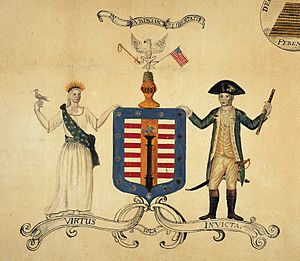
The way the stars were arranged changed a lot over time. The flag laws did not specify how they should be placed. In the late 1700s, a circle of stars was a popular design. Artists and coin designers liked it, as did some flag makers. The circle usually showed that all the states were united and equal.
A flag with a circle of stars was seen as early as 1777. This was at the surrender of General John Burgoyne at Saratoga. An eyewitness wrote that the circle of stars meant the Union would last forever. It also showed that the 13 states were united and equal.
Even though the circle of stars is part of the "Betsy Ross" design, her family documents do not mention this arrangement. Some evidence suggests Betsy Ross might have arranged her stars in rows.
The Colors
Early U.S. flags used many different colors. We do not know the exact meaning behind the colors of the flag until 1782. That year, Charles Thomson wrote about the Great Seal of the United States. He said: "White signifies purity and innocence. Red hardiness and valour and Blue the colour of the Chief signifies vigilance perseverance and justice."
The use of red and blue in flags at this time might be because these colors were easy to make with dyes. However, the simplest reason for the colors is that the American flag was based on British flags. For example, the Grand Union Flag, an earlier American flag, was likely based on the British flag.
Why the Betsy Ross Flag is Important Today
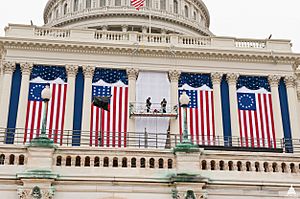
The Betsy Ross flag design, with its clear circle of stars, has become a symbol. It represents the American Revolution and the early years of the United States. William J. Canby's story of Betsy Ross was popular. Americans wanted stories about the revolution and its female heroes. Betsy Ross became a role model for young girls. She showed how women helped shape American history.
The Betsy Ross flag design appears in many famous paintings about the war. These include General George Washington at Trenton (1792) and Washington Crossing the Delaware (1851). During the United States centennial, the Betsy Ross design became very popular. Many flags with this design were made.
At United States presidential inaugurations, a large Betsy Ross flag is traditionally displayed. It is shown next to the modern U.S. flag. This represents the nation's history.
The circle of 13 stars, which defines the Betsy Ross design, is also on two state flags: the Flag of Rhode Island and the Flag of Indiana. The Flag of Missouri has a similar circle of 24 stars. This is because it was the 24th state to join the Union. The United States Foreign Service flag also features the circle of 13 stars.
Since 1963, the Philadelphia 76ers basketball team has used the ring of 13 five-pointed stars in their team logo. This is a nod to Philadelphia being the first U.S. capital. It is also where the Declaration of Independence was signed and where Betsy Ross worked.
- U.S. postage stamps featuring the Betsy Ross flag design


